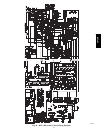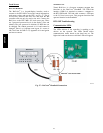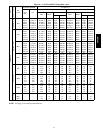
30
entha lpy sensor and the (SR) terminal on the enthalpy
controller.
NOTE: The enthalpy control must be set to the “D”
setting for differential enthalpy control to work properly.
Indoor Air Quality (CO
2
sensor) — The indoor air quality
sensor accessory monitors space carbon dioxide (CO
2
)
levels. This information is used to monitor IAQ levels.
Several types of sensors are available, for wall mounting
in the space or in return duct, with and without LCD
display, and in combination with space temperature
sensors. Sensors use infrared technology to measure the
levels of CO
2
present in the space air.
The CO
2
sensors are all factory set for a range of 0 to
2000 ppm and a linear mA output of 4 to 20. Refer to the
instructions supplied with the CO
2
sensor for electrical
requirements and terminal locations. See Fig. 38 for
typical CO
2
sensor wiring schematic.
To accurately monitor the quality of the air in the
conditioned air space, locate the sensor near a return--air
grille (if present) so it senses the concentration of CO
2
leaving t he space. The sensor should be m ounted in a
location to avoid direct breath contact.
Do not mount the IAQ sensor in drafty areas such as near
supply ducts, open windows, fans, or over heat sources.
Allow at least 3 ft (0.9 m) between the sensor and any
corner. Avoid mounting the sensor where it is influenced
by the supply air; the sensor gives inaccurate readings if
the supply air is blown directly onto the sensor or if the
supply air does not have a chance to mix with the room air
before it is drawn into the return airstream.
Wiring the Indoor Air Quality Sensor —
For each sensor, use two 2--conductor 18 AWG (American
Wire Gage) twisted--pair cables (unshielded) to connect
the separate isolated 24 vac power source to the sensor
and to connect the sensor to the control board terminals.
To connect the sensor to the control, identify the positive
(4 to 20 mA) and ground (SIG COM) terminals on the
sensor. See Fig. 38. Connect the 4--20 mA terminal to
RTU--MP J4--2 and connect the SIG COM terminal to
RTU--MP J4--3. See Fig. 53.
SEN
COM
J4-2
J4-3
IAQ Sensor
24 VAC
C08462
Fig. 53 -- RTU--MP / Indoor CO
2
Sensor
(33ZCSENCO2) Connections
Outdoor Air Quality Sensor (PNO 33ZCSENCO2 plus
weathe rproof enclosure) — The outdoor air CO
2
sensor is
designed to monitor carbon dioxide (CO
2
) levels in the
outside ventilation air and interface with the ventilation
damper in an HVAC system. The OAQ sensor is packaged
with an outdoor cover. See Fig. 40. The outdoor air CO
2
sensor must be located in the economizer outside air hood.
Wiring the Outdoor Air CO
2
Sensor — A dedicated power
supply is required for this sensor. A two--wire cable is
required to wire the dedicated power supply for the sensor.
The two wires should be connected to t he power supply
and terminals 1 and 2.
To connect the sensor to the control, identify the positive
(4 to 20 mA) and ground (SIG COM) terminals on the
OAQ sensor. See Fig. 38. Connect the 4 to 20 mA
terminal to RTU --MP J4--5. Connect the SIG COM
terminal to RTU--MP J4--6.
SEN
COM
J4-5
J4-6
OAQ Sensor/RH Sensor
24 VAC
C08463
Fig. 54 -- RTU--MP / Outdoor CO
2
Sensor
(33ZCSENCO2) Connections
On 50TCQ units equipped with factory--installed Smoke
Detector(s), the smoke detector controller implements the
unit shutdown through it s NC contact set connected t o the
unit’s CTB input. The FSD function is initiated via the
smoke detector’s Alarm NO contact set. The RTU--MP
controller communic ates the smoke detector’s tripped
status to the BAS building control. See Fig. 30, the
PremierLink wiring schematic.
The Fire Shutdown Switch configuration,
MENU
→
Config
→
Inputs
→
input 5, identifies the
normally open status of this input when there is no fire
alarm.
Connecting Discrete Inputs
Filter
Status
The filter status accessory is a field--installed accessory.
This accessory detects plugged filters. When installing
this accessory, the unit must be configured for filter status
by setting MENU
→
Config
→
Inputs
→
input3,5,8,or9
to Filter Status and normally open (N/O) or normally
closed (N/C). Input 8 or 9 is recomme nded for easy of
installation. Refer to Fig. 47 and Fig. 49 for wire
terminations at J5.
Fan Status
The fan status accessory is a field--installed accessory.
This accessory detects when the indoor fan is blowing air.
When installing this accessory, the unit must be
configured for fan status by setting
MENU
→
Config
→
Inputs
→
input3,5,8,or9to Fan
Status and normally open (N/O) or normally cl osed (N/C).
Input 8 or 9 is recommended for easy of installation. Refer
to Fig. 47 and Fig. 49 for wire terminations at J5.
50TCQA


















